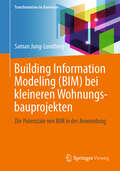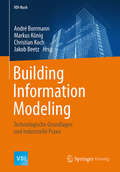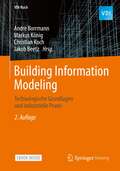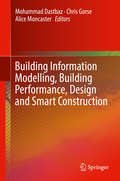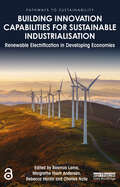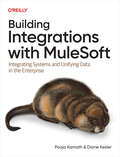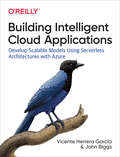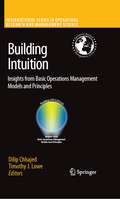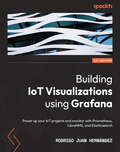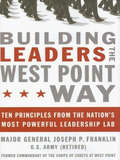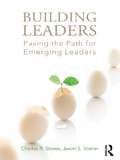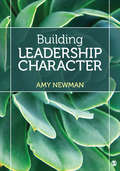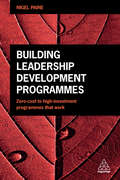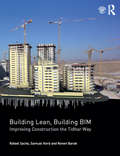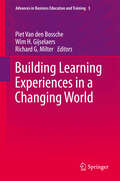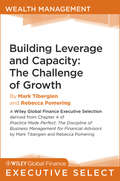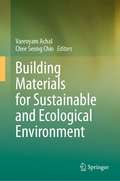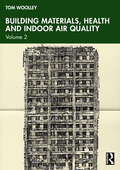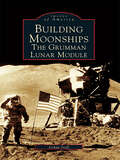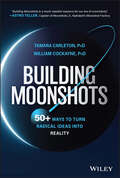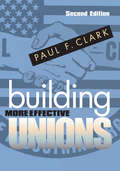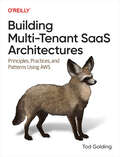- Table View
- List View
Building Information Modeling: DIe Potenziale von BIM in der Anwendung (Transformation im Bauwesen)
by Prof. Dr.-Ing Jung-LundbergDie Notwendigkeit zur Applikation digitaler Methoden im Bauwesen wie Building Information Modeling (BIM) ist in den vergangenen Jahren erkannt worden. Baumaßnahmen sollen zukünftig erst virtuell und dann real gebaut werden. In diesem Kontext wurden in Deutschland bereits diverse BIM – Pilotprojekte durchgeführt. Im Fokus stehen dabei bislang primär Großprojekte. Für die angestrebte Digitalisierung der Baubranche sind jedoch auch die alltäglichen kleineren Projekte zu betrachten. Um eine Prüfung des potenziellen Nutzens von Building Information Modeling in dieser Sparte des Bauwesens zu ermöglichen, hat der Autor bereits 2019 ein entsprechendes Bewertungsmodell entwickelt. Dieses Fachbuch ist inhaltlich auf die Anwendbarkeit von BIM im Bereich ebensolcher Bauprojekte ausgerichtet. Es werden die wichtigsten Informationen zu BIM dargestellt. Anschließend werden anhand eines Praxisprojekts, welches parallel konventionell und BIM-basiert geplant wird, die Vorteile der BIM-Anwendung in kleineren Wohnungsbauvorhaben analysiert. Das Buch richtet sich an Ingenieure und Architekten in kleineren Planungsbüros und an alle BIM interessierten Akteure der Bauwirtschaft.
Building Information Modeling: Technologische Grundlagen und industrielle Praxis (VDI-Buch)
by André Borrmann Markus König Christian Koch Jakob BeetzBuilding Information Modeling (BIM) ist in aller Munde. Diese innovative Technologie, die auf der durchg#65533;ngigen Verwendung digitaler Bauwerksmodelle beruht, ist dabei, die Planungs-, Ausf#65533;hrungs- und Betriebsprozesse im Bauwesen grundlegend zu revolutionieren. Das Buch erl#65533;utert ausf#65533;hrlich die informationstechnischen Grundlagen der BIM-Methode und vermittelt dem Leser fundiertes Wissen zu allen wesentlichen Aspekten. Das gro#65533;e Potential der BIM-Methode wird durch zahlreiche erfolgreiche Anwendungsbeispiele aus der industriellen Praxis belegt, die im Buch detailliert geschildert werden.
Building Information Modeling: Technologische Grundlagen und industrielle Praxis (VDI-Buch)
by André Borrmann Markus König Christian Koch Jakob BeetzBuilding Information Modeling (BIM) ist eine innovative Technologie, die auf der durchgängigen Verwendung digitaler Bauwerksmodelle für alle Planungs-, Ausführungs- und Betriebsprozesse beruht. Das Buch erläutert ausführlich die informationstechnischen Grundlagen der BIM-Methode und vermittelt dem Leser fundiertes Wissen zu allen wesentlichen Aspekten. Die stark überarbeitete zweite Auflage geht ausführlich auf neuste Entwicklungen, u. a. im Bereich der Ausarbeitungsgrade, der BIM-Rollen und der Standardisierung ein und gibt einen vertieften Einblick in die erfolgreiche Einführung von BIM bei namhaften Auftraggebern, Planungsbüros und Bauunternehmen.
Building Information Modelling, Building Performance, Design and Smart Construction
by Mohammad Dastbaz Chris Gorse Alice MoncasterThis book charts the path toward high performance sustainable buildings and the smart dwellings of the future. The volume clearly explains the principles and practices of high performance design, the uses of building information modelling (BIM), and the materials and methods of smart construction. Power Systems, Architecture, Material Science, Civil Engineering and Information Systems are all given consideration, as interdisciplinary endeavours are at the heart of this green building revolution.
Building Innovation Capabilities for Sustainable Industrialisation: Renewable Electrification in Developing Economies (Pathways to Sustainability)
by Rasmus Lema, Margrethe Holm Andersen, Rebecca Hanlin and Charles NzilaThis book argues that renewable electrification in developing countries provides important opportunities for local economic development, but new pathways are required for turning these opportunities into successful reality. Building Innovation Capabilities for Sustainable Industrialisation offers a novel input into the debate on development of capabilities for sustainable industrialisation and delivers key insights for both researchers and policy makers when it comes to the question of how to increase the economic co-benefits of renewables expansion. The chapters in the book use a tailored analytical framework in their studies of renewable electrification efforts in Kenya and other countries in sub-Saharan Africa. They draw on a mix of project, sector and country level case studies to address questions such as: What capabilities are developed through on-going renewable electrification projects in developing economies? How can the expansion of renewable electrification be supported in a way that also encourages sustainable economic development? What role do international linkages (South-South and North-South) play and what role should they play in the greening of energy systems in developing economies? The authors provide a new understanding of how green transformation and sustainable industrialisation can be combined, highlighting the opportunities and constraints for local capability building and the scope for local policy action. This book will be of great interest to students and scholars of development studies, energy studies, sustainability and sustainable development, as well as practitioners and policy makers working in development organisations and national governments.
Building Integrations with MuleSoft
by Pooja Kamath Diane KeslerThis concise yet comprehensive guide shows developers and architects how to tackle data integration challenges with MuleSoft. Authors Pooja Kamath and Diane Kesler take you through the process necessary to build robust and scalable integration solutions step-by-step.Supported by real-world use cases, Building Integrations with MuleSoft teaches you to identify and resolve performance bottlenecks, handle errors, and ensure the reliability and scalability of your integration solutions. You'll explore MuleSoft's robust set of connectors and their components, and use them to connect to systems and applications from legacy databases to cloud services.Ask the right questions to determine your use case, define requirements, decide on reuse versus rebuild, and create sequence and context diagramsMaster tools like the Anypoint Platform, Anypoint Studio, Code Builder, GitHub, and MavenDesign APIs with RAML and OAS and craft effective requests and responsesWrite MUnit tests, validate DataWeave expressions, and use Postman CollectionsDeploy Mule applications to CloudHub, use API Manager to create API proxies, and secure APIs with Mule OAuth 2.0Learn message orchestration techniques for routers, transactions, error handling, For Each, Parallel For Each, and batch processing
Building Intelligent Cloud Applications: Develop Scalable Models Using Serverless Architectures with Azure
by John Biggs Vicente Herrera GarcíaServerless computing is radically changing the way we build and deploy applications. With cloud providers running servers and managing machine resources, companies now can focus solely on the application’s business logic and functionality. This hands-on book shows experienced programmers how to build and deploy scalable machine learning and deep learning models using serverless architectures with Microsoft Azure.You’ll learn step-by-step how to code machine learning into your projects using Python and pretrained models that include tools such as image recognition, speech recognition, and classification. You’ll also examine issues around deployment and continuous delivery, including scaling, security, and monitoring.This book is divided into three parts with application examples woven throughout:Cloud-based development: Learn the basics of serverless computing with machine learning, Functions-as-a-Service (FaaS), and the use of APIsAdding intelligence: Create serverless applications using Azure Functions; learn how to use prebuilt machine learning and deep learning modelsDeployment and continuous delivery: Get up to speed with Azure Kubernetes Service, Azure Security Center, and Azure Monitoring
Building Intuition: Insights from Basic Operations Management Models and Principles (International Series in Operations Research & Management Science #115)
by Timothy J. Lowe Dilip ChhajedThis is the first book in the field that uses the power of the basic models and principles to provide students and managers with an "intuitive understanding" of operations management. The book touches on nine fundamental models and principles, and outlines the key insights behind each one. Some of the very biggest names in the Management Science field have developed and carefully written these chapters on the field's basic models.
Building IoT Visualizations using Grafana: Power up your IoT projects and monitor with Prometheus, LibreNMS, and Elasticsearch
by Rodrigo Juan HernandezThe IoT developer's complete guide to building powerful dashboards, analyzing data, and integrating with other platformsKey FeaturesConnect devices, store and manage data, and build powerful data visualizationsIntegrate Grafana with other systems, such as Prometheus, OpenSearch, and LibreNMSLearn about message brokers and data forwarders to send data from sensors and systems to different platformsBook DescriptionGrafana is a powerful open source software that helps you to visualize and analyze data gathered from various sources. It allows you to share valuable information through unclouded dashboards, run analytics, and send notifications. Building IoT Visualizations Using Grafana offers how-to procedures, useful resources, and advice that will help you to implement IoT solutions with confidence. You'll begin by installing and configuring Grafana according to your needs. Next, you'll acquire the skills needed to implement your own IoT system using communication brokers, databases, and metric management systems, as well as integrate everything with Grafana. You'll learn to collect data from IoT devices and store it in databases, as well as discover how to connect databases to Grafana, make queries, and build insightful dashboards. Finally, the book will help you implement analytics for visualizing data, performing automation, and delivering notifications. By the end of this Grafana book, you'll be able to build insightful dashboards, perform analytics, and deliver notifications that apply to IoT and IT systems.What you will learnInstall and configure Grafana in different types of environmentsEnable communication between your IoT devices using different protocolsBuild data sources by ingesting data from IoT devicesGather data from Grafana using different types of data sourcesBuild actionable insights using plugins and analyticsDeliver notifications across several communication channelsIntegrate Grafana with other platformsWho this book is forThis book is for IoT developers who want to build powerful visualizations and analytics for their projects and products. Technicians from the embedded world looking to learn how to build systems and platforms using open source software will also benefit from this book. If you have an interest in technology, IoT, open source, and related subjects then this book is for you. Basic knowledge of administration tasks on Linux-based systems, IP networks and network services, protocols, ports, and related topics will help you make the most out of this book.
Building Knowledge and Using It Wisely: Rethinking Board Design
by Jay W. Lorsch Colin B. CarterThis chapter addresses a key problem for every board-designing a set of processes and practices so directors can learn and stay better informed about their company and reach informed decisions.
Building Leaders the West Point Way: Ten Principles from the Nation's Most Powerful Leadership Lab
by Joseph FranklinMajor General Joseph P. Franklin (ret.) believes almost everything that he is as an adult can be traced back to his days at West Point, where he was not only a cadet but an instructor, football coach, and eventually Commandant of Cadets. U.S. Military Academy graduates are found at the highest levels in every walk of life: military, education, business, medicine, law, and government. "But," says Franklin, "you don't have to graduate from the U.S. Military Academy to embrace its ideals or to benefit from the wisdom that is taught there. Competent, even inspiring, leadership is within the grasp of nearly everyone." The principles of leadership-including Duty, Honor, Faith, Courage, Perseverance, Confidence, Approachability, Adaptability, Compassion, and Vision-can be internalized and polished to one's own level of expertise and ambition."I have known Joe Franklin, since the late 1970s, when I coached at West Point and he was the Commandant of Cadets. General Joe is well-known by the many people whose lives he has touched as a truly thoughtful, approachable, and compassionate human being. He has written a very readable book using examples drawn from his personal experience to illustrate key principles of leadership, a subject I have studied and practiced for most of my adult life. His simple, honest, easy to understand text is a welcome addition to the references available to leaders, young and old alike. This book will definitely help you become a better leader. The General is one of the best ever!" - Mike "Coach K" Kryzewski, Duke University Basketball Coach
Building Leaders: Paving the Path for Emerging Leaders
by Charles R. Stoner Jason S. StonerThis book is written for emerging leaders. It is designed to help these leaders bridge the gap from stepping into a position of leadership and emerging as a confident and respected difference-maker. Within this text, award-winning scholar and leader-coach Charles Stoner meets emerging leaders where they are and focus on the issues that are most problematic for them. From the development of leadership skills to the practice and application of successful strategies, Stoner offers tools, ideas, and evidence-based advice to these up-and-coming leaders in an indispensable text that is direct, pragmatic, and action-oriented. Major topics include: Recognition, development, and practice of organizational leadership skills. Enhancing interpersonal dynamics and relationships. Organizational politics and interpersonal influence, creativity and innovation, negotiation and conflict resolution. Handling problem situations; effectively utilizing diverse talents and personalities. Introduction to major leadership and interpersonal development techniques. Case studies.
Building Leadership Character: Lessons In Authenticity And Credibility
by Amy NewmanExtending beyond traditional leadership books to offer readers a path for developing their own character, this compelling new text uses a storytelling approach and real-world cases to explore different dimensions of leadership character. With a clear, student-friendly writing style, bestselling author Amy Newman deftly captures various approaches in which corporations and people respond to situations in difficult times and learn from mistakes. Using real companies and situations, each chapter examines a leadership character dimension such as accountability, integrity, authenticity, and courage. Readers will learn to develop their own character, emotional intelligence, and leadership skills as they engage with assessments, reflection opportunities, and exercises.
Building Leadership Character: Lessons In Authenticity And Credibility
by Amy NewmanExtending beyond traditional leadership books to offer readers a path for developing their own character, this compelling new text uses a storytelling approach and real-world cases to explore different dimensions of leadership character. With a clear, student-friendly writing style, bestselling author Amy Newman deftly captures various approaches in which corporations and people respond to situations in difficult times and learn from mistakes. Using real companies and situations, each chapter examines a leadership character dimension such as accountability, integrity, authenticity, and courage. Readers will learn to develop their own character, emotional intelligence, and leadership skills as they engage with assessments, reflection opportunities, and exercises.
Building Leadership Development Programmes: Zero-Cost to High-Investment Programmes that Work
by Nigel PaineMost leadership development runs on rails: courses are organized with standard content usually delivered by companies set up expressly for that purpose. Most leadership programmes fail when judged on whether they achieve lasting impact and behaviour change because what is covered is often forgotten after the programme ends. Building Leadership Development Programmes is designed to show how leadership development should work. It challenges the widely accepted notion that leadership development cannot be measured and it exemplifies how to design programmes that are in line with organizational needs and deliver lasting and measurable impact. Building Leadership Development Programmes is structured around detailed case studies from around the world that offer unique insights into the process of building effective leadership development, looking at a range of approaches from almost zero cost options to high end investment that actually works. It helps readers think through what it is that they are actually trying to achieve, offering processes to work through to establish what is necessary for their organization and take a longer view than looking for quick fixes. It features case studies including Crotonville Leadership Centre who have worked with GE, McKinsey and the Red Cross, and interviews with world authorities on leadership and talent development. Detailed guidance will help identify the right measures to ensure impact, and to adopt the right methodologies, including looking at leadership coaching, mentoring, social learning and action learning, blowing apart the idea that expensive training courses are always required.
Building Lean, Building BIM: Improving Construction the Tidhar Way
by Rafael Sacks Samuel Korb Ronen BarakBuilding Lean, Building BIM is the essential guide for any construction company that wants to implement Lean Construction and Building Information Modelling (BIM) to gain a strategic edge over their competition. The first of its kind, the book outlines the principles of Lean, the functionality of BIM, and the interactions between the two, illustrating them through the story of how Tidhar Construction has implemented Lean Construction and BIM in a concerted effort over four years. Tidhar is a small-to-medium-sized construction company that pioneered a way of working that gave it a profit margin unheard of in its market. The company's story serves as a case study for explanation of the various facets of Lean Construction and BIM. Each chapter defines a principle of Lean and/or BIM, describes the achievements and failures in Tidhar's implementation based on the experiences of the key people involved, and reviews the relevant background and theory. The implementation at Tidhar has not been a pure success, but by examining their motives alongside their achievements and failures, readers will learn about what pitfalls and pinnacles to expect. A number of chapters also compare the experience of Tidhar with those of other companies who are leaders in their fields, such as Skanska and DPR. This book is highly relevant and useful to a wide range of readers from the construction industry, especially those who are frustrated with the inefficiencies in their companies and construction projects. It is also essential reading for Lean and BIM enthusiasts, researchers and students from a variety of industries and backgrounds.
Building Learning Experiences in a Changing World (Advances in Business Education and Training #3)
by Wim H. Gijselaers Piet Van den Bossche Richard G. MilterAdvances in Business Education & Training is a Book Series to foster advancement in the field of Business Education and Training. It serves as an international forum for scholarly and state-of-the-art research and development into all aspects of Business Education and Training. This new volume deals with several aspects of the challenge to design learning in and for a changing world. The first part concerns program development. How to build curricula that are future-proof? Principles to innovate our curricula are identified. It answers the question how we can incorporate the need for change in our thinking about curriculum-development and identify the necessary elements to incorporate in our curricula. The second part focuses on the increasing diversity of students and employees within our schools and organizations, in terms of culture, language, and perception of ability, gifts, and talents. This offers a range of opportunities, but at the same time can possibly jeopardize some processes that are taken for granted. Chapters in this part analyze the processes that play a crucial role in dealing with this diversity and identify educational practices that can help to harvest the potential that lies within this diversity. The third part of this book digs further into the possibilities that are opened up by the implementation of ICT-support in our learning environments. E-learning provides tools to adapt these environments to the needs of an increasingly diverse student-population. In the last part we focus specifically on the workplace and how learning can be designed in such a way that employees are equipped for a shifting workplace. On the one hand it is looked how training can affect performance in the workplace. Does learning transfer to the work environment? On the other hand it is questioned how one can design affordances to trigger learning in the workplace.
Building Legislative Coalitions for Free Trade in Asia
by Megumi NaoiWhat accounts for the large reduction in trade barriers among new democracies in Asia after World War II? Using new data from Japan and Thailand, this book provides a surprising answer: politicians, especially party leaders, liberalized trade by buying off legislative support with side-payments such as pork barrel projects. Trade liberalization was a legislative triumph, not an executive achievement. This finding challenges the conventional 'insulation' argument, which posits that insulating executives from special interest groups and voters is the key to successful trade liberalization. By contrast, this book demonstrates that party leaders built open economy coalitions with legislators by feeding legislators' rent-seeking desires with side-payments rather than depriving their appetites. This book unravels the political foundations of open economy.
Building Leverage and Capacity: The Challenge of Growth (Wiley Global Finance Executive Select #147)
by Rebecca Pomering Mark C. TibergienOne of the most important strategies for a successful investment advisory or wealth management firm is how to manage growth and profits. Once an advisory firm begins to add any staff, it has started to accelerate its growth. It will need to monitor and measure performance, coach and counsel people, produce an increasing amount of revenue to cover the added overhead, and invest in more technology solutions, office space, and employee benefits. Author Mark Tibergien, named by Investment Advisor as one of the most influential people in the industry, provides a comprehensive analysis of: Managing the rising costs of an advisory firm Management and quality control Client satisfaction Training staff Filled with models, statistics, and case studies, this chapter from Practice Made Perfect looks at the client-service approach, infrastructure, and compensation techniques necessary for an advisory firm to grow into an elite practice.
Building Materials for Sustainable and Ecological Environment
by Varenyam Achal Chee Seong ChinThis book uses theories, hypotheses, policies, practical insights and case studies to introduce and elucidate green building materials for sustainable construction. Cement is the most widely used building material in construction; however, it is not sustainable, being responsible for 7% of global carbon dioxide emissions and consuming huge quantities of energy. In order to limit the ecological damage, sustainable building materials are needed. Ecosystems are a source of important lessons and models for transitioning the built environment onto a sustainable path that opens options for sustainable building material in construction. The book provides a guide for readers seeking knowledge on sustainable building materials with the potential to lower environmental impact by reducing CO2 emission throughout the building’s lifecycle. The book is motivated by recent rapid advances in sustainable building materials production, including green building materials made of industrial by-products and recycled wastes, earth materials, plant-based materials, microbial-based materials or supplementary cementitious materials, to reduce the environmental impacts of traditional building materials. Discussing the development and applications of various sustainable building materials, including related case studies, and addressing the environmental issue with a holistic and systematic approach that creates an ecology of construction for sustainability in infrastructures, it offers promising solutions to achieve renewable and sustainable building materials for the future.
Building Materials, Health and Indoor Air Quality: Volume 2
by Tom WoolleyIn Building Materials, Health and Indoor Air Quality: Volume 2 Tom Woolley uses new research to continue to advocate for limiting the use of hazardous materials in construction and raise awareness of the links between pollutants found in building materials, poor indoor air quality and health problems. Chapters in this volume reinforce previous arguments and present new ones covering: Further evidence of the health impacts of hazardous emissions from materials Hazardous materials to be avoided and why Fire and smoke toxicity – the Lakanal House and Grenfell Tower legacy Sub-standard retrofits leading to damp and mould in previously sound houses A critical review of recent reports from UK Government and others on air quality and health problems including policy changes on flame retardants Growing evidence of cancer risks and the failure of cancer research organisations to address these issues A critical review of recent climate change and zero carbon policies and a discussion on whether extreme energy efficiency is a good thing This book asks some important and, for some, uncomfortable questions, but in doing so it brings to light important areas for research and provides much needed guidance for architects, engineers, construction professionals, students and researchers on hazardous materials and how to reduce their use and design and build healthier buildings for all occupants.
Building Moonships: The Grumman Lunar Module (Images of America)
by Joshua StoffIn 1961, after the United States had acquired a total of fifteen minutes of spaceflight experience, President John F. Kennedy announced his plans for landing a man on the moon by 1970. The space race had begun. In 1962, after a strenuous competition, the National Aeronautics and Space Administration (NASA) announced that the Grumman Aircraft Engineering Corporation of Bethpage, Long Island, had won the contract to build the lunar module-the spacecraft that would take Americans to the moon. This was the first, and the only, vehicle designed to take humans from one world to another.Although much has been written about the first men to set foot on the moon, those first hesitant steps would not have been possible without the efforts of the designers and technicians assigned to Project Apollo. Building Moonships: The Grumman Lunar Module tells the story of the people who built and tested the lunar modules that were deployed on missions as well as the modules that never saw the light of day. This is the first publication to chronicle the visual history of the design, construction, and launch of the lunar module-one of the most historic machines in all of human history.
Building Moonshots: 50+ Ways To Turn Radical Ideas Into Reality
by Tamara Carleton William CockayneSolve the world’s biggest problems and create a better future In Building Moonshots: 50+ Ways to To Turn Radical Ideas Into Reality, a team of expert innovation strategists delivers an exciting and insightful collection of strategies, techniques, and frameworks for scaling your next big, audacious idea into a concrete product or service. Each proven and tested strategy contained in the book has been categorized to make it easy to find and implement when you need it most. You’ll learn how and where to start, when to bet big, how to invest, when to play the long game, what to communicate, and much more. You’ll also find: Ways to go beyond white papers and vision statements to a place where your ideas become a tangible reality Strategies for creating a better future by transforming seemingly impossible ideas into concrete products Methods for bringing to life radical and innovative solutions to the world’s greatest challengesDestined to become the seminal, go-to source for visionaries, gamechangers, and leaders imagining the apparently impossible and determined to achieve it, Building Moonshots is a can’t-miss book for entrepreneurs, founders, product development heads, and other business leaders.
Building More Effective Unions
by Paul F. ClarkEmployers have long turned to behavioral science for guidance on making their organizations more effective. Labor scholar Paul F. Clark believes union leaders should also take advantage of the valuable discoveries made in this field, and he offers a straightforward account of how they can do so. Much of the behavioral science research relevant to unions relies on complex statistical analyses and is disseminated through scholarly journals. This clearly written book makes the findings of behavioral science accessible to those committed to building a stronger labor movement. It describes behavioral science's understanding of such topics as organizational commitment and member participation and suggests how this knowledge can best be applied to unions. The book features examples of how unions and their leaders have benefited from putting the principles of behavioral science into practice.
Building Multi-Tenant SaaS Architectures: Principles, Practices, and Patterns Using AWS
by Tod GoldingSoftware as a service (SaaS) is on the path to becoming the de facto model for building, delivering, and operating software solutions. Adopting a multi-tenant SaaS model requires builders to take on a broad range of new architecture, implementation, and operational challenges. How data is partitioned, how resources are isolated, how tenants are authenticated, how microservices are built—these are just a few of the many areas that need to be on your radar when you're designing and creating SaaS offerings.In this book, Tod Golding, a global SaaS technical lead at AWS, provides an end-to-end view of the SaaS architectural landscape, outlining the practical techniques, strategies, and patterns that every architect must navigate as part of building a SaaS environment.Describe, classify, and characterize core SaaS patterns and strategiesIdentify the key building blocks, trade-offs, and considerations that will shape the design and implementation of your multi-tenant solutionExamine essential multi-tenant architecture strategies, including tenant isolation, noisy neighbor, data partitioning, onboarding, identity, and multi-tenant DevOpsExplore how multi-tenancy influences the design and implementation of microservicesLearn how multi-tenancy shapes the operational footprint of your SaaS environment
